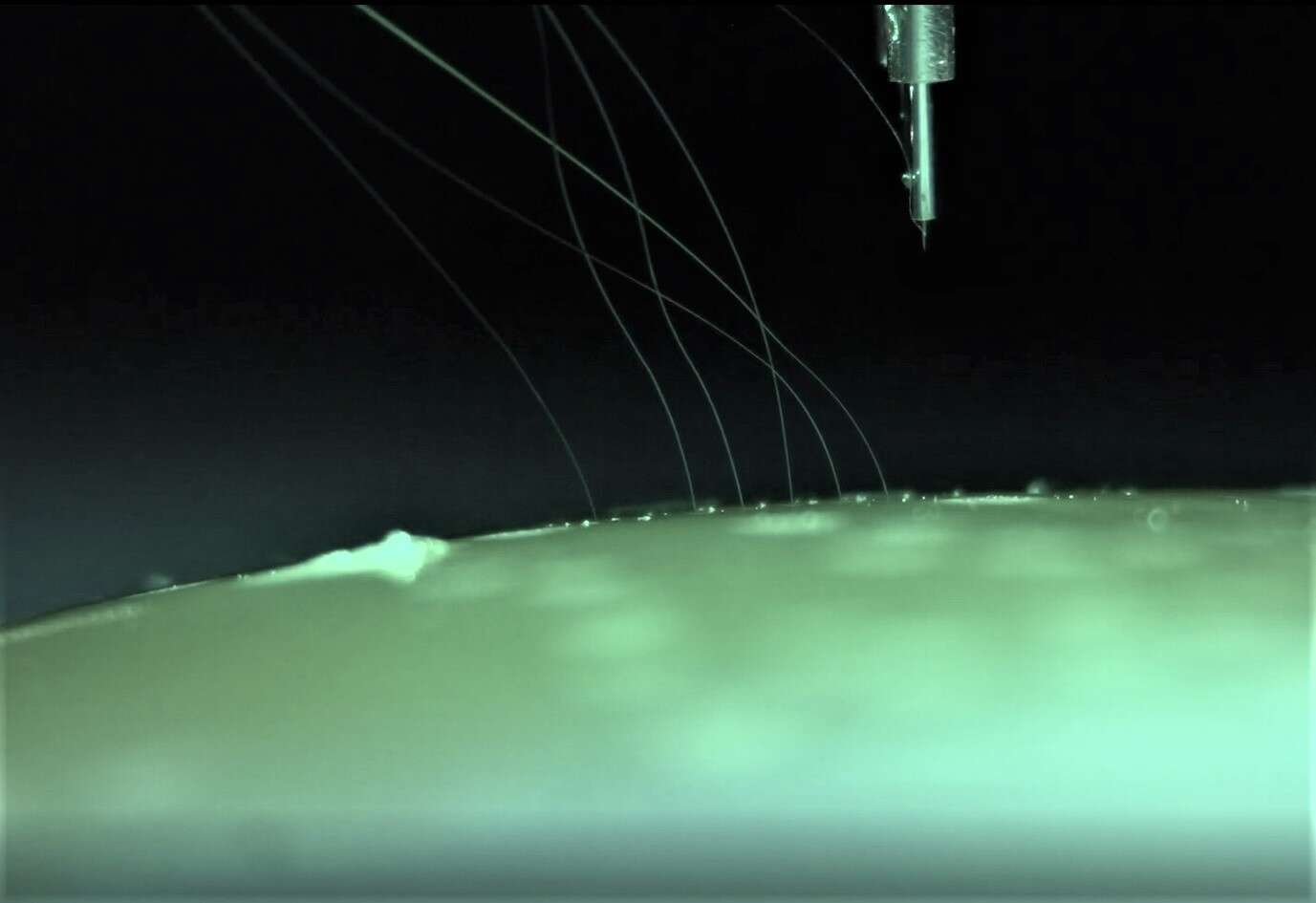
Your brain, with a USB-C port in it. That’s Elon Musk’s vision for Brain Machine Interfaces (BMI). In a controversial July 2019 white paper he claimed that his company Neuralink had taken a huge step towards building a “scalable high-bandwidth BMI system” that would let the human brain “stream full broadband electrophysiology data” to a network, using a combination of ultra-fine polymer probes, a neurosurgical robot that sews them into the brain, and custom high-density electronics.
A “single USB-C cable provides full-bandwidth data streaming from the device” the paper noted: the device having been stitched, in theory, to your cerebral cortex. Neuroscientists were varying shades of intrigued, appalled and dismissive: the custom hardware would only pick up noise, they suggested: interpretation of brain waves simply wasn’t that advanced; the ethical issues were pronounced; the body would reject this level of intervention; where was the peer review of the paper?
A year later, Musk has promised a Neuralink update.
This was cryptically announced by Musk in July 2020, with the Tweets: “If you can’t beat em, join em Neuralink mission statement” and “Progress update August 28”. Ten days ahead of the reveal, we decided to take stock of Neuralink’s work’s and the ongoing discussion around the potential of BMI; speaking to a range of specialists in the sector about where the work was going and how realistic Musk’s vision was.
Neuralink began as a way to advance the technology of BMI: described by one organisation, the Mayo Clinic, as a technology that “acquires brain signals, analyses them and translates them into commands that are relayed to output devices that carry out desired actions”. (Many observers suspect that the pending update will have to do with the “analyse them” part of that statement, and Musk’s “if you can’t beat ’em” statement refer to his well-documented concerns about the power of AI.)
These “desired actions” could be how to move a wheelchair without the use of your arms or how to control bionic limbs: “It is plausible to imagine that a patient with spinal cord injury could dexterously control a digital mouse and keyboard” wrote Musk in the 2019 paper. “When combined with rapidly improving spinal stimulation techniques, in the future this approach could conceivably restore motor function. High-bandwidth neural interfaces should enable a variety of novel therapeutic possibilities”.
While this might be the starting point for Neuralink, the ambitions of those working closely on BMI include, for some, the hope that technology could eventually to be used to connect the human race via a bona fide “neural network”; allowing people to communicate using thoughts and images rather than words, and even give over their motor function to others, with their consent*. The ideas behind this have their roots in a dizzying transhumanism. Meanwhile, very physical issues have remained a hurdle…

Credit: Neuralink
Silicon in the Skull
The most commonly used invasive BMI chip, the Utah Array, comprises an electrode with tiny, incredibly sharp silicone needles, that are pushed into the brain, after some skull has been cut away. There are less invasive ways of collecting data on brain activity but in general terms, the more invasive the technology, the more data from the brain scientists can catch. Neuralink’s tech is similar, but designed to gather even more data on how the brain works. The electrodes are long threads rather that short needles, allowing it to follow contours, and sewn into the brain rather than placed on top.
(Musk’s robot can accurately sew six sensor threads, or electrodes, per minute into the human brain, via small holes in the skull: “The robot registers insertion sites to a common coordinate frame with landmarks on the skull, which, when combined with depth tracking, enables precise targeting of anatomically defined brain structures. An integrated custom software suite allows pre-selection of all insertion sites, enabling planning of insertion paths optimised to minimise tangling and strain on the threads.”)
These sorts of advancements in BMI have been largely avoided by neuroscientists at any significant scale due to their invasiveness; although testing on rats and chimpanzees is happening. The consequences of getting things wrong are significant. As Dr Henry Marsh, a leading English neurosurgeon, warned in one interview after the initial paper was published: “The brain does not heal in the way bone and muscle and skin heals. Every time you cut the brain you damage it, and it won’t recover…”
However, there are varying degrees of damage depending on the materials used. Co-founder and CSO of full stack neural interface platform BIOS, Oliver Armitage, explained the differences to Computer Business Review as follows: “With the existing material, when you’re using stiff materials like silicone, silicone substrates and metals, the finer and pointier and deeper into the tissue you go, the more damage you create. With some of the newer technologies based on soft polymer electrodes, that trade-off [between invasiveness and accuracy of data] doesn’t really hold anymore”.
With these new, somewhat less invasive, cutting edge sensors, Musk also hopes to cure those who need treatment with BMI technologies successfully enough to move on to pioneering recreational use. Here is where the academics are divided. Ideally in the next 50 years some BMI advocates hope to equip those who can afford it with tech that will ostensibly enable them to communicate without speaking, access a “hive mind” for any information they need and sense their houses and the appliances in them as easily as if they were on their bodies: no more “Alexa, do this…”, or “Hey Google…” You just think it and it happens: an “Internet of Things” in which you are at one with the things.
“The idea would be instead of you and I talking right now, we would somehow link up our brain signals and ‘poof’, everything that you needed to know would come from me” explained Dr Robert Kirsch PhD, Chairman of the Department of Biomedical Engineering at the Case Western Reserve University and Executive Director at the Functional Electrical Stimulation (FES) centre in Cleveland.
He noted: “I’m not sure that that’s the right path” (to go down with this kind of innovation). “There are many things that they can do with this technology to improve human life. But it may not be in [its use for things like] social media. I think that that’s a simplistic view. I think the the notion that we’re going to take the machines into our minds, that otherwise they are going to take over because we communicate too slowly. They didn’t really need to do that. There’s a lot of need for brain interfacing that has nothing to do with making Facebook work better”.
Neuralink update eagerly awaited, but “the brain is very complex… “
Postdoctoral researcher at Swiss Federal Institute of Technology in Zurich, Giacomo Valle, who has a PhD in Biorobotics, explained the difficulties neuroscientists meet in actually decoding the data picked up by the electrodes: “Technology, at a certain point, will arrive at a limit because we have thousands and thousands of hundreds of thousands of neurons, and our electrode has hundreds of active sites or maybe thousands or maybe ten thousand. But that’s not enough to record each neuron in your brain. We also have other techniques now, like deep learning or machine learning, to decode motor intention, so we are growing in terms of technology. But the brain is very complex and we are still far from decoding exactly all of its interactions. To read your feelings and your mind, that this is something that is not possible”.
But something like it may be possible, even within a 15-year time frame, according to BIOS CSO Armitage: “To get to the point where people can telepathically communicate information in very short periods of time by communicating through series of images? I think that’s technically feasible over a 10 to 15 year timescale.”
Dr Kirsch and Armitage agree that the innovations in the technology itself are pretty ground-breaking: “The system that Elon Musk has developed is extremely promising” said Dr Kirsch. “And it would enable us to do things that we cannot do right now. The electrodes that we use now are in an array and they’re all the same length. You press them down on the surface of the brain, they only go in a millimetre and a half. Luckily, it hits important places in motor control. However, your brain’s big, and there are a lot of areas that are very important that we can’t simply reach.
“[The cerebral cortex] has valleys and hills and we can’t get into any of those valleys”.
Neuralink’s sensors have been designed to get data from these valleys in the cerebral cortex. As Dr Kirsch continued: “His electrodes will go there. They’re long and they have multiple recording contacts along the length, we just have one. He hired some really top notch scientists to develop that. I think it has huge potential”.
The Signal and the Noise
The problem is, while it may seem preferable to field as much data as possible to learn more about how the brain works, there is not much information out there as to how to decode the brainwaves once they have been recorded. This, however, is the vocation of the company BIOS and the passion of Oliver Armitage.
As he puts it: “The point of a neural interface is to transfer information in and out of the nervous system. The nervous system is data flowing around the body. If the genome is the body’s hard drive, the nervous system is the body’s Internet. The nervous system is like the real time information that’s moving around the body, telling an organ what to do. Fundamentally, it’s a data transmission system.
“Our core focus is on information conversion; being able to analyse vast amounts of neural data in order to understand what it means and then put information back in, in order to change it once you’ve understood it…
He adds: “There are nerves going to every single organ, telling the organ what to do and providing information back to the brain about what that organ is doing at that point in time. The health care usage of this is to interact with those nervous system signals, understand them using machine learning based on large neural datasets. And then when you change one of those signals, you can change the organ function and hence treat a disease. The reason this is used as a therapy, is that if you block a signal that’s going from the brainstem to the heart to cause it to beat harder in order to raise the blood pressure, if you block that signal out, you can lower someone’s blood pressure, neurally”.
Where does AI enter into this? “We use AI for decoding and encoding the nervous system, both understanding the data and putting information back in, generating a stimulation and then generating activity in the nerves that looks natural”.
Data from the brain gets broken down into different neural phrases, which when linked to the actions they provoke, can be strung together to create a precise neural pathway that can be understood by the brain and translated into a function, written into the brain, by researchers at BIOS: “We think about that as a neural language. It’s like building a language translator between a language that you don’t know, all you know is what happens afterwards. From that you have to decode all the words.”
While these innovations are pioneering, exciting, and clearly have therapeutic potential, could BMIs should be used recreationally in future?
“Musk is overreaching…”
A leading expert in socially responsible technology innovation Dr Andrew Maynard told us “I think Musk’s overreaching and he probably knows it.
“That said, Elon Musk has got a track record of doing things that other people said can’t be done. So I think that this is going to be an interesting space because of that… [But] I think we’re a long way from understanding how this works.
“Even with Elon Musk’s system you have around ten thousand electrodes. There are billions of neurons in your brain. It’s a needle in a haystack”.
Gabriel Baud-Bovy is assistant professor at the Faculty of Psychology of the San Raffaele University and a specialist in the challenges of sensori-motor coordination.
He notes: “[Elon Musk] is starting with the somatosensory cortex and motor cortex in terms of what he’s targeting; firstly in mice and later in humans; I think they’re looking for their first test now… [In those sections of the brain] you have very strong signals about the direction of the motion so you can control a robotic arm; it’s not too difficult to to decode that signal. But if you look at what is happening with those neurons, there is much more information than simply the direction of motion… Some other neurons will be sensitive to the context in which the action is taking place.
“AI works well when the context is well-defined. But as the situation becomes more ‘real life’ progress becomes like mist, in a sense… We are very far from understanding what’s happening in the brain” finished Baud-Bovy, laughing.
A sense of how incomplete our understanding of the brain is can be illustrated with reference to the fruit fly. Fruit flies have small brains containing only 100,000 neurons, in comparison to humans, which are equipped with over one 100,000,000,000 neurons. Early this year, researchers managed to map 25,000 of those neurons and the way in which their activity helped form over 20 million connections.
It took over a decade of development and research partnerships to not just create the reconstructed fly brain and render the visualisations interactive, but also correctly label individual synapses. That was for one quarter of a fly’s brain.
Armitage summed up the complexity of the human brain with what he called a theoretically intractable problem: “Famously, there aren’t enough atoms in the universe to build a full model of what every cell is doing [in the brain]. It’s a theoretically intractable problem, you can’t even conceive of a computer large enough because there isn’t enough material in the universe to make it”.
Musk may be about to make huge strides forwards in using AI to map and interpret signals from the brain. But “joining” humanity with AI? That’s a long way off.
*As a July 2020 paper in the Journal of Neurosurgery notes, this idea is not far-fetched: “[Researchers] have demonstrated the viability of, and developed an operative protocol for, a fully implantable brain stimulation system in pigeons. By use of this system to stimulate the ventral part of the nucleus intercollicularis and formatio reticularis medicalis mesencephalic structures, pigeons were deviated from their usual flight paths. And by electrode implantation in the nigrostriatal pathway of rats, Koh et al. were able to direct them through a maze using electrical stimulation…”






